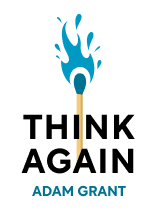

This article is an excerpt from the Shortform book guide to "Think Again" by Adam Grant. Shortform has the world's best summaries and analyses of books you should be reading.
Like this article? Sign up for a free trial here.
What is Adam Grant’s book Think Again about? What is the key message to take away from the book?
You likely believe that precise knowledge is valuable and that maintaining strong beliefs shows integrity. But according to Adam Grant, the author of Think Again, reconsideration, or the ability to reconsider your views, is much more valuable than knowledge or loyalty to your beliefs.
Below is a brief overview of Think Again: The Power of Knowing What You Don’t Know by Adam Grant.
Think Again: The Power of Knowing What You Don’t Know
In his book Think Again, Grant argues that knowledge and expertise often confine us to narrow ways of thinking that limit our potential. He says that instead of pursuing expertise, we should practice and pursue reconsideration because it opens new doors of learning and self-awareness.
Reconsideration is the ability to question, investigate, and analyze your opinions and beliefs. Grant says that reconsideration is a crucial skill for critical thinking that can apply to many aspects of your life. In this section, we’ll explain why reconsideration is so important, why most people don’t do it, and how you can engage in it.
Benefits of Reconsideration
Grant says that there are many benefits to reconsideration that positively affect your interactions with others, your sense of humility, and your openness to new ideas.
Benefit #1: Improving Your Interactions With Others
There are three ways that your interactions improve when you stay open to questioning and analyzing your ideas:
- You have more productive conversations and disagreements—Grant says that reconsideration helps you engage with others more open-mindedly. You become able to start conversations from a place of curiosity, leading to more productive collaborations with others.
- You avoid defensive behavior—when others challenge your beliefs, reconsideration helps you stay open to reconsidering them. Grant says that this openness prevents you from becoming anxious and defensive.
- You prevent personal echo chambers—when you reconsider your opinions and beliefs, you start to consider different points of view. Grant says that reconsideration prevents you from living in a personal bubble in which your personal beliefs go unquestioned and helps you interact with those who have different beliefs.
Benefit #2: Developing Self-Awareness and Humility
Grant writes that there are two ways in which reconsideration can help you develop a better sense of self-awareness and humility:
- You become aware of your biases and assumptions—Grant says that questioning what you know forces you to reflect on your biases and assumptions.
- You develop a sense of humility—reconsideration helps you realize that you are not always right. Grant says that this awareness develops your sense of humility about your abilities and knowledge.
Benefit #3: Being More Open to New Ideas
Grant writes that reconsideration can help you become more open to new ideas in two primary ways:
- It allows you to embrace being wrong—practicing reconsideration helps you realize that being wrong isn’t negative. It’s an opportunity to learn something new.
- It instills in you a love of discovery and new knowledge—instead of feeling apprehensive and anxious when you run into something you don’t know, you’ll feel excited about what you’re about to discover.
Why Reconsideration Doesn’t Happen
Despite its benefits, you may find it challenging to practice reconsideration because beliefs and opinions aren’t just ideas—they’re a foundational way of identifying yourself and distinguishing yourself from others. Any challenge during an argument can threaten your core sense of identity.
Grant notes that feeling threatened in this way often triggers one of three defensive mindsets:
- Self-righteous: You assert the supremacy of your principles. You believe you’ve already found the correct position, and don’t consider that your beliefs may not be accurate or applicable to every situation.
- Argumentative: You believe that the other person is wrong or doesn’t have all the facts. You put together arguments to prove yourself right, and you become combative instead of listening thoughtfully to the other person’s ideas.
- Persuasive: You want others to agree with you, adopt your beliefs, and take up your cause, so you use persuasion to get your way. Convincing others that your way is best—rather than determining if it really is the best—becomes your main priority.
The Conviction-Assumption Process
Grant notes that outwardly defensive behaviors often coincide with an inward thought process that reinforces your beliefs and closes you off to reconsideration. In this guide, we call this process the Conviction-Assumption Process (Grant uses the term Overconfidence Cycle) and it operates in the following sequence:
The Conviction-Assumption Process will almost always prove you right—leading to calcified thinking in which you don’t question your views or critique your conclusions. This happens because by continuously confirming your viewpoints, you reinforce your way of thinking as “right” and become blind to the perspectives of others. Being unaware of other points of view results in a false sense of certainty regarding the validity of your opinions and causes you to become overconfident in your decision-making.
Bridge the Gap Between Assumption and Reconsideration
Grant says that the first step in avoiding the Conviction-Assumption Process is knowing that you need to reconsider your views and being able to admit when you’re wrong.
To develop your ability to admit when you’re wrong, Grant says that you must first detach your identity from your beliefs and opinions. He shares two suggestions for this:
Suggestion #1: Differentiate Your Current Self From Your Past Self
Detach yourself from your old beliefs by reflecting on who you used to be and how you have changed. Explore this concept by drawing a Venn diagram that shows the beliefs and values of your past self and how they compare with your beliefs and values today.
Suggestion #2: Identify With Your Morals, Not Your Opinions
Learn to identify with morals and values rather than opinions or beliefs. Morals and values are your core principles (for example, generosity, kindness, or creativity). Grant asserts that morals and values provide a broader and more flexible framework for your identity than beliefs because you can apply them consistently across a broad range of situations. A belief, on the other hand, is usually far more narrow and specific, and it is less able to adapt to new evidence.
For example, a teacher believes that assigning homework is beneficial and feels threatened by recent evidence suggesting that homework provides few benefits. But when the teacher identifies creativity as a core value, she considers if there are more creative, effective ways to reinforce her lessons. She becomes open to adapting and experimenting with new methods that work best for her students—instead of being restricted to her old ways by her narrow belief.
The Reconsideration Process
When you disconnect your beliefs from your identity, you begin to see your beliefs and opinions as untested hypotheses rather than absolute truth.
This allows you to engage in a healthier way of thinking: the Reconsideration Process (Grant calls this the Rethinking Cycle). Grant contrasts this process to the Conviction-Assumption Process—you approach your beliefs with curiosity rather than certainty, and you investigate what you don’t know instead of clinging tightly to old beliefs and becoming defensive. You express humility and doubt about the topic, ask questions, and gain knowledge.
Improve Your Ability to Reconsider
We now have the Reconsideration Process as a mental framework to keep top of mind—it helps you slow down and examine what you really know in any situation. In this section, we’ll discuss three methods for improving your ability to reconsider:
- Examine your views
- Learn to balance doubt and confidence
- Embrace complexity
Method #1: Examine Your Views
Grant suggests examining your views by assessing what you know, investigating new information, and possibly drawing new conclusions based on your research.
First, reframe your views as hypotheses. This will help you see them as questions to investigate rather than statements of fact.
Then, experiment with the hypotheses by gathering new information. Grant recommends making an effort to seek out information that contradicts your existing beliefs.
Write down your original hypotheses, how they have changed, and your new conclusions. Obtaining this new information can change the direction of your thinking. New information that disproves your initial assumptions can change how you think about your original beliefs.
Method #2: Finding a Balance Between Doubt and Confidence
As you engage in the Reconsideration Process and examine your ideas, it is important to improve your ability to reconsider by learning to balance confidence and doubt. Grant points out that having too much confidence in your beliefs and abilities makes you too assured that all your views are correct, but too much doubt makes you fearful and unable to act.
When your doubt and confidence are balanced, you have faith in your abilities and can acknowledge that you may have more to learn—you’re neither stuck in your convictions nor paralyzed by self-doubt. Grant says there are several ways to balance your level of doubt and confidence:
Be Honest About Your Abilities
Have a realistic understanding of your capabilities. When you consider yourself capable of handling a task or mastering a concept, you run the risk of becoming too self-assured and too focused on what you already know. As a result, you don’t think about your weaknesses or knowledge gaps, which will make it difficult for you to improve your skills or integrate new information.
Acknowledge Your Limitations
Acknowledge your limitations positively—without putting yourself down. Instead, Grant encourages you to make an effort to view your weaknesses as opportunities to learn, grow, and improve yourself.
Discover Your Knowledge Gaps
Put together all the information you have about a subject and try to explain it to another person—if they have trouble understanding you or seeing the logical connections in your arguments, that’s a strong indication that you may need to do more research into the topic.
Method #3: Consider Complexity
As you practice reconsideration, you must also learn to consider complexity—elements or considerations that add nuance to your beliefs or conclusions.
Grant asserts that assuming that you have a complete understanding of a topic causes you to believe that your views apply in every circumstance and that there are no other valid interpretations. These beliefs dismiss the complexity of the issue at hand—the many circumstances or applications that might challenge your viewpoint. For example, you may believe that your neighborhood grocery store is charging too much for their goods without considering why they might do this—perhaps they’re forced to charge higher prices to keep up with their rising cost of rent.
On the other hand, Grant says, acknowledging the complexity of a situation initiates the Reconsideration Process: When you consider the many nuances of a problem, you cast doubt on your conviction that you have a complete understanding of the issue, which inspires you to consider new questions.
Grant suggests several methods for adding complexity to a topic:
Consciously Look at Different Angles
There can be different ways of interpreting the information available about a topic, and your point of view will become more nuanced if you consider different viewpoints. Making a conscious effort to look at these angles makes you open to new perspectives.
Question Your Understanding
Ask yourself if you fully understand the topic—look into different resources to ensure you are up to date on the latest research and have a full picture of the topic.
Avoid Stereotypes
As you consciously add complexity to your knowledge base and your daily interactions, you will also get better at avoiding stereotypes: general qualities you assign to a type of person or group based on assumptions or biases. Stereotypes often stem from a lack of awareness about the complexity of the perspectives of others.
Grant suggests thinking hypothetically about what you would be like if you had a different background—you’ll likely come to realize that the experiences of others are much more complex than you’d assumed. He suggests some “hypotheses” to examine, such as: Could I be wrong about how I think about this group of people? Is it really true that all X people do Y? How does their background differ from mine, and how has that informed the different ways we live?
This sparks the Reconsideration Process—you realize that your stereotypes are incorrect, seek correct information about different groups, and come away with a nuanced understanding of them rather than a stereotype.
Teach Others to Reconsider Their Views
Now that you have a solid understanding of reconsideration and have learned how to practice it in your own life, you can confidently and competently teach others these skills so they can re-examine their beliefs, engage in open-minded thinking, and learn about new ideas.
In this chapter, we’ll discuss some different opportunities to show others how to practice reconsideration: in educational settings and during disagreements in your personal and professional life.
Teaching Opportunity #1: Education
A vital way to help others apply reconsideration in their lives is to teach the concept in schools and other educational settings. Grant says that when you take on the role of an educator (perhaps as a parent, co-worker, friend, or mentor), it is important to make reconsideration central to how you educate others so they can examine their beliefs and be open to new ideas.
Bringing Reconsideration Into the Classroom
Grant critiques traditional education methods such as lecture and memorization as inadequately challenging students to think independently. These methods teach students to repeat the information they learn but not how to engage meaningfully with the material. As a result, they don’t develop adequate critical thinking skills. Instead of lecture and memorization, Grant advocates for an active-learning approach that encourages students to question their thinking and engage curiously and meaningfully with other people’s ideas.
Suggestions for Active Learning and Reconsideration in the Classroom
Grant provides some suggestions for encouraging active learning and reconsideration:
One method is to assign projects that involve multiple drafts with peer feedback (feedback that a small peer group provides)—having students complete multiple drafts shows them that they may need to make mistakes and reconsider their ideas several times in order to meet the project goals.
Teachers can also encourage students to share their passions—when students hear about the interests of their peers, they realize that other students have something to teach them and that they might benefit from the ideas of others.
Finally, teachers can empower students to question widely accepted beliefs—Grant says that teachers should create lessons that debunk myths and challenge conventional thinking. For example, many people believe that violent crime is at an all-time high in major American cities. However, a self-directed lesson plan that teaches students how to analyze crime statistics over the past 40 years could show them that crime rates have actually fallen dramatically over that timespan. This would help students bust a widely held myth and teach them that many things that are widely assumed to be true don’t hold up to closer inspection.
Teaching Opportunity #2: Collaborative Disagreements
A second way to teach others reconsideration skills is through collaborative disagreement. Disagreeing collaboratively means that you and the other person have a natural give and take and maintain an openness to working together. Grant says that when you think of disagreement in this way, you can approach it as a fluid exchange of ideas—a generative and creative interaction rather than a combative argument.
How to Have a Collaborative Disagreement
Grant says that the first step in teaching reconsideration through collaborative arguments is to frame the interaction as a healthy debate rather than a confrontation. Grant suggests that you say, “I would love to debate this issue with you.” This reassurance makes people understand that your goal is to explore ideas, not question their judgment or challenge their identity.
Once you establish that your disagreement is a discussion rather than a fight, Grant suggests several techniques to demonstrate collaborative engagement to your counterpart.
- Express genuine interest in what the other person has to say. Expressing interest teaches the other person that their views are important and reassures them that they don’t have to take a defensive stance.
- Only present your strongest points. Present a small selection of strong arguments so you don’t overwhelm your partner and make them feel defensive. (Shortform note: Experts say you can identify strong arguments based on the evidence that supports the idea. If it lacks good evidence, it’s probably not a good argument.)
- Ask a lot of contemplative questions. When you ask questions, you encourage the other person to engage in question-oriented thinking, too. And because they’re now in question-asking mode, they may start to reconsider some of their beliefs leading them away from their more hardline stances.
- Express how you are feeling throughout the interaction. Expressing emotion teaches the other person that it is safe to be honest about how they feel. (Shortform note: Psychologist Carl Rogers suggests an additional way to make others feel safe in difficult conversations—expressing “unconditional positive regard” for them. In a specifically therapeutic context, this means maintaining a non-judgmental attitude no matter what the other person might say, letting them express all their emotions openly, and accepting them as they are.)
Apply Reconsideration at Work
The third area where Grant suggests you can apply reconsideration is in your workplace. Applying reconsideration in this context creates positive work cultures which prioritize learning and critical thinking over profit and end results. In this section, we’ll explore:
- How to create a psychologically safe environment at work
- How to establish decision-making processes in the workplace that best allow you to apply the principles of reconsideration
Creating Psychological Safety in the Workplace
The best way to lay the groundwork for reconsideration in the workplace is to cultivate psychological safety: the sense that you can take risks when interacting with others without fearing negative consequences.
Grant says that ideas go unexpressed when workplaces don’t try to cultivate this sense of safety—people fear the negative consequences of being wrong, so they hesitate to speak up. In such a culture, old ways of doing things go unquestioned because people are stigmatized for challenging them. When this dynamic sets in, the workplace can become wedded to old ideas and processes that clearly aren’t working anymore, while new ideas are stifled and ignored—leading the entire organization to suffer as a result.
To avoid this outcome, Grant says leaders should cultivate psychological safety by communicating that it’s ok to be wrong. Even better, they can openly share professional critiques that show their past failures. When leaders are open about their own shortcomings and how they are working to do better, it provides a powerful example of humility that gives employees the psychological safety to struggle and make mistakes too.
Reconsideration in Action During the Decision-Making Process
Once psychological safety sets the stage for reconsideration, how can you effectively use it? Grant says that the decision-making process—gathering data, generating ideas, and analyzing ideas—is where you, as a leader, can most effectively apply the concepts of reconsideration.
Grant advises revamping how conversations happen during the decision-making process: Instead of having team members share only their final decisions, they should share the entire process they used.
Grant explains the benefits of team members sharing their entire process:
- A thorough explanation of the group’s thinking helps the whole team understand how and why decisions were made. Those outside the process can point out possible weaknesses or alternate solutions.
- When the decision-making process is communicated and fully documented, mistakes are less likely to be repeated in future iterations. Fully documenting the process can allow others to fix faulty underlying logic that may have contributed to an unsuccessful result.
- This way of making decisions and communicating the process prompts team members to think through new ideas, investigate the processes that generated those ideas, and analyze the conclusions. As we saw earlier in the guide, this can kickstart the Reconsideration Process because it encourages everyone to recognize what they don’t know and begin to question prior assumptions.
Reconsider Your Life Goals
We’ve now explored how to apply reconsideration in all areas of your life so that you—and the people you teach and work with—can become open-minded thinkers. We have seen how reconsideration helps you reassess your beliefs, and so we can now use this skill to reconsider your beliefs about the paths you should take in your life.
You may have set your sights on a specific goal early on in life, without considering whether or not this goal fits what you want out of life. Parents and teachers often encourage this, but Grant says that when you form your life goals too early, they can become a core part of your identity. As a result, you become resistant to reconsidering your goals because doing so would threaten who you are as a person. Instead, when it occurs to you that you may be on the wrong path, you may feel threatened—you’ll double down and commit to working even harder to achieve your goals. This, of course, only serves to push you even further down an undesirable life path.
Continually Reevaluate Your Path
To avoid getting stuck on a life path you don’t want to follow, Grant suggests reviewing your goals periodically on your own or with a partner, mentor, or friend. Put a reminder on your calendar to do this once or twice a year.
During these check-ins, ask yourself:
- “What has changed personally or professionally since I first decided to take this path?”
- “Have my personal goals changed?”
- “Am I challenged by what I am doing, or do I feel I have learned all I can in this role?”
- “Have I reached a turning point?”
Committing to regularly reconsidering your life goals means that you may change course multiple times. Grant emphasizes that this is okay—this process of changing course gets you ever closer to your true path.

———End of Preview———
Like what you just read? Read the rest of the world's best book summary and analysis of Adam Grant's "Think Again" at Shortform.
Here's what you'll find in our full Think Again summary:
- Why the ability to reconsider is more important than precise knowledge
- How knowledge and expertise can narrow your thinking and limit your potential
- How to improve your ability to reconsider things in work and in life






